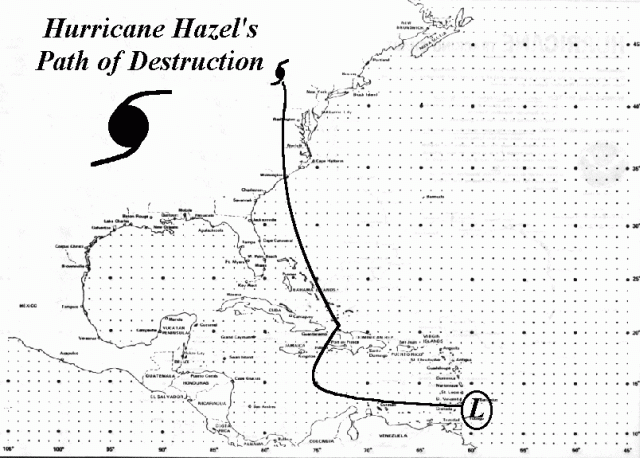HAZEL October 14th - 16th 1954 . This Hurricane refused to die over land and maintained a lot of its strength after it came ashore in South Carolina with 140 mph winds. The eye passed directly over Hagerstown. The rains from Hazel in Hagerstown was only about 3 inches but some nearby surrounding areas recieved alot more with flooding. The winds were the biggest problem doing alot of severe damage in the area. Sustained winds of 60 mph with a recorded peak gust in Chewsville Md. of 92 mph for the highest official measured gust ever in this area. Hazel, the eighth hurricane of the year 1954 to menace the Atlantic Coast of North America, will long be remembered for its contrary moves and wide spread destruction. In recent years men of this part of the world have learned much of how to foresee action in these tropical disturbances as they wind their way northward from the Caribbean, but Hazel seemed to have ideas all her very own and behaved in a most unpredictable manner. Although the majority of these storms actually strike inhabited shores only once or twice in their northward rush, Hazel was probably a record breaker with the number of blows it dealt as it traversed Caribbean Islands, a great portion of our eastern states and part of Canada, leaving approximately 400 persons dead or missing and property damage untold. This great storm was the worst in the history of the Coastal Carolinas and was undoubtedly the most destructive. Most factors which ordinarily contribute to the destructive power of hurricanes seemed to be on Hazel's side. It came upon our coast at exactly high water during a full moon tide in the fall of the year, when tides are unusually high normally. Its powerful winds were officially estimated at Oak Island Coast Guard Station at 140 miles per hour. One advantage the people had, however, was of much importance, and that was the arrival of Hazel in daylight hours. If this same storm had borne down on this area in the darkness of night, countless more lives would have been lost and property damage would have been much greater on our shore lines. Twenty persons were dead or missing in the two Carolinas after the passing of Hazel and property damage in these two states is figured at an estimate of 60 million dollars. South Carolina lost one person, but damage was high on the beaches. Total estimate of damage from Pawleys Island to Cherry Grove Beach was 24 million dollars. There were 273 houses destroyed at Myrtle Beach, representing 80 percent of the waterfront development. Ocean Drive lost 450 houses, Crescent Beach lost 200, Windy Hill Beach 120 of 270 and Cherry Grove Beach 300 of 450 houses. Damage to North Carolina's Beach resorts alone will exceed 36 million dollars. In the area from Atlantic Beach to the South Carolina line hardly any waterfront property escaped major damage. The coast of Brunswick County bore the brunt of the storm, with the eye passing directly across the area, but the greatest dollar loss was to New Hanover Beach alone was probably as high as 17 million dollars, which includes 362 buildings completely destroyed and 288 with major damages. The amusement area was badly wrecked and damage there alone was estimated at one million dollars. Hotels there escaped major damage. Damage at Wrightsville Beach was estimated at 7 million dollars, where there were 89 buildings completely destroyed and about 155 heavily damaged. At New Topsail Beach 210 of 230 houses were destroyed and property loss was estimated at $2,435,000. Atlantic Beach, on the northern fringe of the danger area, was not so heavily hit. There the loss of buildings was 35 while 105 suffered major damage ann loss was figured at $1,863,000. At Long Beach 352 of 357 buildings were destroyed, at Holden Beach all but 12 of 150 were lost, and on Ocean Isle, where the greatest loss of life occurred, all but two of 33 cottages, Colonial Beach all 24, Fort Caswell Beach lost 73 and at Fort Fisher there were five buildings destroyed.
The
great hurricane of 1954 will remain in the minds of all
the people of the people of the coastal Carolinas always.
In a few years there will be little or no visible scars
-- a few new inlets formed and some old landmarks wiped
out will be the only permanent results. However, we
believe that a lasting record, made up of a collection of
the most striking and descriptive pictures available,
would serve an interesting and useful purpose to friends
and relatives in other parts of the country and to future
generations. |
